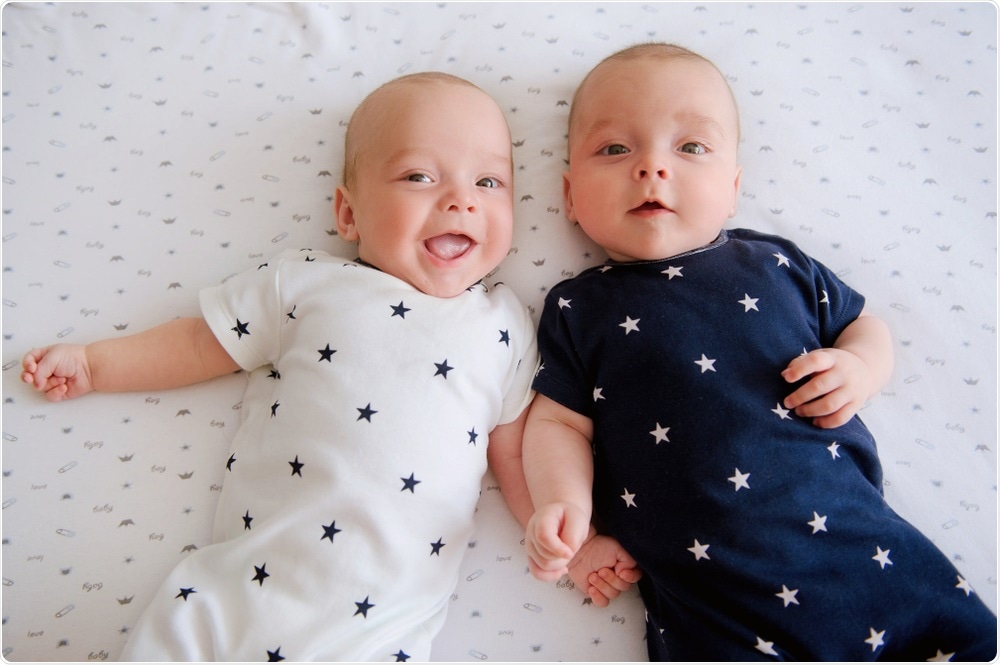After approximately three decades of a steady increase, the rate of twin births in the US has fallen for the first time, with a downward trend observed between 2014 and 2018.
 Zoia Kostina | Shutterstock
Zoia Kostina | Shutterstock
Between 1980 and now
Following years of relative stability, the US birth rate for twins started to climb in the early 1980s, increasing by 79% between 1980 and 2014, says the CDC. In 1980, one in every 53 births was a twin birth, while in 2014 this figure had dropped to one in every 29.
The rise in twin births, which was widespread and observed in all US states had mainly been attributed to the take up of in vitro fertilization techniques.
What has changed?
Until recently, in vitro fertilization would often involve the transfer of multiple embryos to increase the likelihood of success. However, this would also increase the likelihood of multiple births if more than one embryo was successful.
However, recent advances in reproductive technology have meant that many fertility doctors now only transfer one embryo at a time. The progress made in embryo freezing and genetic testing have helped increase the success rate of single embryo transfers.
It is important to monitor twin birth rates
The CDC says it is important to monitor the rate of twin births, since twins are at an increased risk for poor outcomes compared with singletons, including pre-term birth and newborn morbidity and mortality.
Using Data from the National Vital Statistics System, they conducted a trend analysis in twin childbearing overall between 1980 as well 2018, as well based on maternal age, race and Hispanic origin, and state of residence between 2014 and 2018.
Key findings of the report were as follows:
- Following more than three decades of increases, the twin birth rate declined by 4% between 2014 and 2018. 2018 saw the lowest rate in more than a decade, which was 32.6 twins per 1,000 total births.
- The number of twin deliveries declined by an average of 2% per year from 2014 through to 2018, falling to 123,536 births in 2018.
- Twin birth rates declined among mothers aged 30 and over, with the largest declines observed for mothers aged 40 and older.
- The twin birth rate fell by 7% among non-Hispanic white mothers between 2014 and 2018, but remained essentially the same among non-Hispanic black and Hispanic mothers.
- Twin birth rates declined in 17 states and increased in three states.
The CDC did not publish figures on triplets or other multiple births, but said the data suggests it is trending the same way.
Decline driven by white women and those aged 30 or older
The overall 4% decline observed for the 2014-2018 period was not universal across maternal age, race, and Hispanic-origin, or across US states, the report says.
The report’s lead author, Joyce Martin, noted the decline was driven by white women and women aged 30 years or older. Those two groups represent the largest number of customers to pay out for costly in vitro fertilization treatments, which are involved in roughly 15% of multiple births.
There have also been changes in how the technique is carried out.
The technique involves surgically removing eggs from a woman’s ovaries, mixing them with sperm in the laboratory, and, after a few days, transferring the fertilized embryo(s) into the woman’s womb.
More than ten years ago, standard practice was to implant two or more embryos to increase the likelihood of success. Since then, researchers have discovered how to grow embryos for longer periods in the lab and made advances in genetic testing to check for problems.
This has improved clinicians’ ability to select the most viable embryo to use, says Aaron Styer, an infertility treatment specialist in Chestnut Hill, Massachusetts.
The success rate for a single embryo transfer has risen rose from around 20% in the 1980s to about 50% today, he said.
About two-thirds of IVF procedures now use one embryo
Today, about two-thirds of IVF procedures only use one embryo, according to CDC researcher Dmitry Kissin.
Although the 4% drop is only modest, health officials are welcoming the news. Multiple births increase the risks of complications and death for both the mother and the baby.
"In the media, there are often stories about very cute twins," says Kissin. “These stories don’t focus on the risk."
Examples of risks to mothers include diabetes, high blood pressure, hemorrhaging and postpartum depression, while babies are more likely to be born premature and to have a low birth weight.
"I am elated," said one fertility specialist from Texas. "What I take away from this is that we’re working hard to ensure that families have the healthiest pregnancies possible," he concludes.